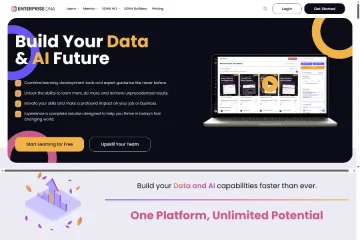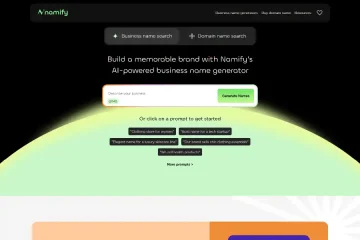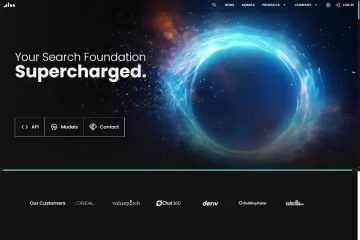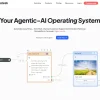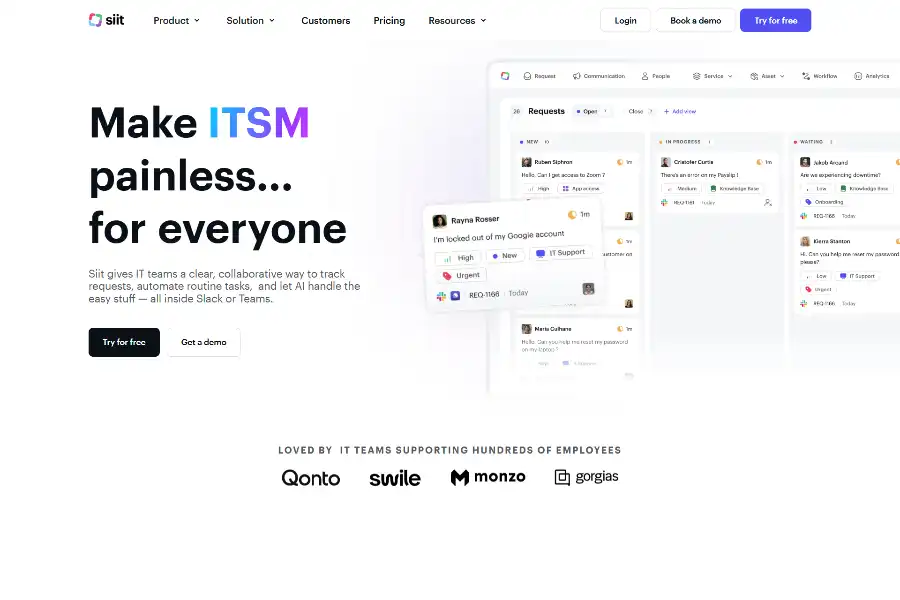
Comprehensive Analysis of Siit: A Modern ITSM Solution
Introduction
In the rapidly evolving landscape of IT service management (ITSM), traditional methods of handling service requests through email threads and clunky portals have become outdated. Modern IT teams require solutions that are efficient, scalable, and seamlessly integrated into their existing workflows. Siit, a cutting-edge ITSM platform, addresses these challenges by leveraging the power of AI and integration with popular collaboration tools like Slack and Microsoft Teams. This comprehensive analysis will delve into the technical principles, functional features, market applications, user feedback, competitive advantages, and future prospects of Siit.
Technical Principles
Siit’s core functionality is built around the integration of AI agents and automation workflows to streamline service requests. The platform utilizes natural language processing (NLP) to enable AI agents to handle level 1 service requests through conversational interfaces directly within Slack or Teams. This approach not only enhances user experience but also reduces the burden on IT teams by automating routine tasks. The AI agents are capable of understanding and responding to user queries in a human-like manner, ensuring seamless interaction.
Moreover, Siit’s automation capabilities are powered by its ability to connect with existing directories and execute workflows based on predefined triggers and actions. This zero-touch automation ensures that service requests, such as hardware requests and application access, are processed without manual intervention. The platform’s architecture is designed to be scalable and adaptable to various organizational needs, making it suitable for both IT and non-IT teams.
Functional Features
Siit offers a suite of features designed to enhance ITSM efficiency and collaboration. Key features include:
- Slack & Teams Native Integration: Siit allows users to manage service requests directly within Slack or Teams, eliminating the need for separate portals and reducing the time spent switching between applications.
- AI-Driven Service Requests: The platform’s AI agents handle low-level requests through natural, conversational language. If a request requires human intervention, it is automatically routed to the appropriate person, ensuring quick resolution.
- Service Request Automations: Siit automates service requests with zero-touch workflows, connecting to directories and executing actions based on triggers. This feature helps track hardware requests, application access, and other routine tasks without manual effort.
- Department-Level Permissions: Siit’s built-in permissions system ensures secure collaboration across departments by limiting access to sensitive information based on departmental needs.
- Centralized Request Dashboard: Users can view and manage all service requests in one centralized dashboard, providing full context from HRIS and other systems.
- Built-in CMDB: Siit includes a built-in configuration management database (CMDB) that allows organizations to track and manage hardware and software assets from a single database.
- Service Catalog: The platform offers a structured service catalog where employees can choose the type of service they need and define their requests, making it easier for IT teams to process.
- Out-of-the-Box Integrations: Siit seamlessly integrates with essential tools and platforms, ensuring that organizations can leverage their existing technology stack.
- Reporting & Analytics: Siit provides key metrics and analytics on request trends, SLA achievement, and frequent issues, helping organizations monitor the health of their IT operations.
Market Applications
Siit’s versatility makes it applicable across various industries and organizational sizes. Here are some notable use cases:
- Technology Companies: IT teams in tech companies often face a high volume of service requests. Siit’s automation and AI-driven features help them manage these requests efficiently, freeing up resources to focus on more complex issues.
- Healthcare Organizations: In the healthcare sector, Siit’s secure collaboration features and department-level permissions ensure that sensitive patient information is handled appropriately while streamlining IT support processes.
- Financial Institutions: Financial organizations require robust security and compliance. Siit’s built-in permissions and integration capabilities make it an ideal solution for managing IT service requests while maintaining regulatory standards.
- Educational Institutions: Schools and universities can benefit from Siit’s centralized request dashboard and service catalog, making it easier for staff and students to access IT support and resources.
User Feedback and Market Reception
User feedback indicates that Siit has been well-received by organizations looking to modernize their ITSM processes. Key points highlighted by users include:
- Efficiency Improvements: Users report significant reductions in the time spent on routine tasks, thanks to Siit’s automation features. This allows IT teams to handle more requests with fewer resources.
- Ease of Use: The integration with Slack and Teams is highly praised, as it allows users to manage service requests without leaving their preferred collaboration tools.
- Security and Compliance: Organizations appreciate Siit’s department-level permissions and secure collaboration features, which help maintain data privacy and compliance.
- Scalability: Siit’s ability to scale with organizational growth is a major advantage, making it suitable for both small and large enterprises.
Market research data also shows that Siit has gained a strong foothold in the ITSM market, with a growing number of organizations adopting its platform to improve their service management processes.
Competitive Advantages
Siit’s competitive edge lies in its combination of AI-driven automation, seamless integration with popular collaboration tools, and robust security features. Compared to traditional ITSM solutions, Siit offers:
- Higher Efficiency: By automating routine tasks and enabling AI-driven interactions, Siit significantly reduces the time and resources required to manage service requests.
- Enhanced Collaboration: The platform’s native integration with Slack and Teams, along with its department-level permissions, ensures that teams can collaborate effectively without compromising security.
- Scalability: Siit is designed to grow with organizations, making it a future-proof solution for ITSM needs.
- User Experience: The conversational interface and centralized dashboard provide a user-friendly experience, making it easier for both IT and non-IT teams to adopt and use the platform.
Future Development
Looking ahead, Siit is poised to continue innovating and expanding its capabilities. Potential future developments may include:
- Enhanced AI Capabilities: As AI technology advances, Siit is likely to incorporate more sophisticated NLP and machine learning algorithms to further improve its automation and interaction capabilities.
- Expanded Integrations: Siit may continue to expand its integration options to include a broader range of tools and platforms, ensuring seamless compatibility with various technology stacks.
- Advanced Analytics: Future versions of Siit may offer more advanced analytics and reporting features, providing deeper insights into IT operations and helping organizations make data-driven decisions.
- Global Expansion: With increasing demand for modern ITSM solutions, Siit may focus on expanding its market reach, targeting organizations in different regions and industries.
Conclusion
Siit represents a significant advancement in the field of IT service management, offering a modern, efficient, and user-friendly solution that leverages AI and automation to streamline service requests. Its integration with popular collaboration tools, robust security features, and scalable architecture make it a compelling choice for organizations looking to modernize their ITSM processes. As the demand for efficient and intelligent ITSM solutions continues to grow, Siit is well-positioned to lead the way in transforming how organizations manage their IT services.
For more information and to explore Siit’s capabilities firsthand, visit Siit’s official website.

